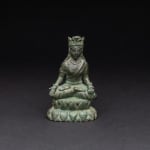Gandharan Bronze Sculpture of Avalokitesvara, 7th Century CE - 9th Century CE
Bronze
12.7 x 7 cm
5 x 2 3/4 in
5 x 2 3/4 in
SF.102
Further images
The Gandharan-Swat Valley-Kashmiri region was a melting pot of various people and arts and served as link between India and Central Asia and further eastwards for a constant flow of...
The Gandharan-Swat Valley-Kashmiri region was a melting pot of various people and arts and served as link between India and Central Asia and further eastwards for a constant flow of Buddhist pilgrims. The area flourished under the Kushan and their greatest king, Kanishka, who traditionally given credit for further spreading the philosophies of Buddhism throughout central Asia and into China. This period is viewed as the most important era in the early history of Buddhism. Some of the earliest representations of the Buddha in his human form date to the Kushan era, as do the first depictions of Bodhisattvas.
In the Buddhist religion, Bodhisattvas are souls who have attained enlightenment and no longer need to reincarnate, but forsake nirvana and choose to come back in order to alleviate the suffering of others. They act as mediators on behalf of mankind to historical or Primordial Buddhas. Bodhisattvas are traditionally depicted dressed in royal attire, festooned with jewellery and a crowns featuring an image of one of the Primordial Buddha, revealing their cosmic lineage. One of the most popular Bodhisattvas, Avalokitesvara is worshiped throughout the Buddhist world. He is first mentioned in the Lotus Sutra, which explains his flower attribute. Although he is known by many names -- Chenrezi in Tibet, Lokesvara in Nepal, Kannon in Japan, Guanyin in China -- he is universally loved for his benevolence towards all human beings. As the guiding deity of the Gelukpa monastic order, the Dalai Lama is considered to be an emanation of this Bodhisattva.
Seated on a throne of double-lotus base in vajra posture, he lays his both hands on his lap, his right forming the varada mudra hand and his left holding a water flask. The face with elongated eyes and asserting eyebrows is topped by a tall foliate crown, showing affinity to Kashmiri style, while his eyes, his urna, and his necklaces are inlaid with silver, a typical practice of Swat Valley production. Thus, this fine bronze Buddha figure is an ensemble of various stylistic elements from adjacent areas.
In the Buddhist religion, Bodhisattvas are souls who have attained enlightenment and no longer need to reincarnate, but forsake nirvana and choose to come back in order to alleviate the suffering of others. They act as mediators on behalf of mankind to historical or Primordial Buddhas. Bodhisattvas are traditionally depicted dressed in royal attire, festooned with jewellery and a crowns featuring an image of one of the Primordial Buddha, revealing their cosmic lineage. One of the most popular Bodhisattvas, Avalokitesvara is worshiped throughout the Buddhist world. He is first mentioned in the Lotus Sutra, which explains his flower attribute. Although he is known by many names -- Chenrezi in Tibet, Lokesvara in Nepal, Kannon in Japan, Guanyin in China -- he is universally loved for his benevolence towards all human beings. As the guiding deity of the Gelukpa monastic order, the Dalai Lama is considered to be an emanation of this Bodhisattva.
Seated on a throne of double-lotus base in vajra posture, he lays his both hands on his lap, his right forming the varada mudra hand and his left holding a water flask. The face with elongated eyes and asserting eyebrows is topped by a tall foliate crown, showing affinity to Kashmiri style, while his eyes, his urna, and his necklaces are inlaid with silver, a typical practice of Swat Valley production. Thus, this fine bronze Buddha figure is an ensemble of various stylistic elements from adjacent areas.











